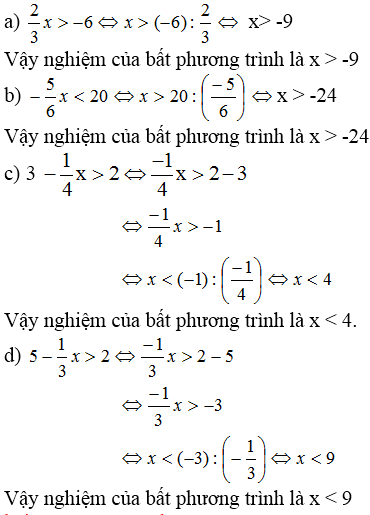Hãy nhập câu hỏi của bạn vào đây, nếu là tài khoản VIP, bạn sẽ được ưu tiên trả lời.

b: \(\Leftrightarrow4x^2-8x+4=x^2+2x+1+3\left(x^2+x-6\right)\)
\(\Leftrightarrow3x^2-10x+3=3x^2+3x-18\)
=>-13x=-21
hay x=21/13
c: \(\Leftrightarrow\left(\dfrac{x-90}{10}-1\right)+\left(\dfrac{x-76}{12}-2\right)+\left(\dfrac{x-58}{14}-3\right)+\left(\dfrac{x-36}{16}-4\right)+\left(\dfrac{x-15}{17}-5\right)=0\)
=>x-100=0
hay x=100

\(\dfrac{x+1}{94}+\dfrac{x+2}{93}+\dfrac{x+3}{92}=\dfrac{x+4}{91}+\dfrac{x+5}{90}+\dfrac{x+6}{89}\)
\(\Rightarrow\dfrac{x+1}{94}+1+\dfrac{x+2}{93}+1+\dfrac{x+3}{92}+1=\dfrac{x+4}{91}+1+\dfrac{x+5}{90}+1+\dfrac{x+6}{89}+1\)
\(\Rightarrow\dfrac{x+95}{94}+\dfrac{x+95}{93}+\dfrac{x+95}{92}=\dfrac{x+95}{91}+\dfrac{x+95}{90}+\dfrac{x+95}{89}\)
\(\Rightarrow\dfrac{x+95}{94}+\dfrac{x+95}{93}+\dfrac{x+95}{92}-\dfrac{x+95}{91}-\dfrac{x+95}{90}-\dfrac{x+95}{89}=0\)
\(\Rightarrow\left(x+95\right)\left(\dfrac{1}{94}+\dfrac{1}{93}+\dfrac{1}{92}-\dfrac{1}{91}-\dfrac{1}{90}-\dfrac{1}{89}\right)=0\)
Vì \(\dfrac{1}{94}+\dfrac{1}{93}+\dfrac{1}{92}-\dfrac{1}{91}-\dfrac{1}{90}-\dfrac{1}{89}\ne0\) nên \(x+95=0\Leftrightarrow x=-95\)
Mk làm luôn nhé , không chép lại đề đâu !!! Ahihi
\(\dfrac{x+1}{94}+1+\dfrac{x+2}{93}+1+\dfrac{x+3}{92}+1=\dfrac{x+4}{91}+1+\dfrac{x+5}{90}+1+\dfrac{x+6}{89}+1\)⇔\(\dfrac{x+95}{94}+\dfrac{x+95}{93}+\dfrac{x+95}{92}-\dfrac{x+95}{91}-\dfrac{x+95}{90}-\dfrac{x+95}{89}=0\)
⇔ \(\left(x+95\right)\)\(\left(\dfrac{1}{94}+\dfrac{1}{93}+\dfrac{1}{92}-\dfrac{1}{91}-\dfrac{1}{90}-\dfrac{1}{89}\right)\) = 0
⇔\(x+95=0\)
⇔ \(x=-95\)
Vậy , ......

\(\dfrac{x-90}{10}+\dfrac{x-76}{12}=\dfrac{x-58}{14}+\dfrac{x-36}{16}+\dfrac{x-15}{17}=15\)
\(\Leftrightarrow\left(\dfrac{x-90}{10}-1\right)+\left(\dfrac{x-76}{12}-2\right)=\left(\dfrac{x-58}{14}-3\right)+\left(\dfrac{x-36}{16}-4\right)+\left(\dfrac{x-15}{17}-5\right)\)\(\Leftrightarrow\dfrac{x-100}{10}+\dfrac{x-100}{12}=\dfrac{x-100}{14}+\dfrac{x-100}{16}+\dfrac{x-100}{17}\)
\(\Leftrightarrow\left(x-100\right)\left(\dfrac{1}{10}+\dfrac{1}{12}-\dfrac{1}{14}-\dfrac{1}{16}-\dfrac{1}{17}\right)=0\)
\(\Leftrightarrow x-100=0\)
\(\Rightarrow x=100\)
Vậy \(S=\left\{100\right\}\)

a) \(\dfrac{x}{3}-\dfrac{2x+1}{2}=\dfrac{x}{6}-x\)
\(\Leftrightarrow\dfrac{2x}{6}-\dfrac{3\left(2x+1\right)}{6}=\dfrac{x}{6}=\dfrac{6x}{6}\)
\(\Leftrightarrow2x-3\left(2x+1\right)=x-6x\)
\(\Leftrightarrow2x-6x-3=x-6x\)
\(\Leftrightarrow2x-6x-x+6x=3\)
\(\Leftrightarrow x=3\)
\(S=\left\{3\right\}\)
b) \(\dfrac{2+x}{5}-0,5x=\dfrac{1-2x}{4}+0,25\)
\(\Leftrightarrow\dfrac{4\left(2+x\right)}{20}-\dfrac{10x}{20}=\dfrac{5\left(1-2x\right)}{20}+\dfrac{5}{20}\)
\(\Leftrightarrow4\left(2+x\right)-10x=5\left(1-2x\right)+5\)
\(\Leftrightarrow8+4x-10x=5-10x+5\)
\(\Leftrightarrow4x-10x+10x=5+5-8\)
\(\Leftrightarrow4x=2\)
\(\Leftrightarrow x=\dfrac{1}{2}\)
\(S=\left\{\dfrac{1}{2}\right\}\)

a) ĐKXĐ: x # 1
Khử mẫu ta được: 2x - 1 + x - 1 = 1 ⇔ 3x = 3 ⇔ x = 1 không thoả mãn ĐKXĐ
Vậy phương trình vô nghiệm.
b) ĐKXĐ: x # -1
Khử mẫu ta được: 5x + 2x + 2 = -12
⇔ 7x = -14
⇔ x = -2
Vậy phương trình có nghiệm x = -2.
c) ĐKXĐ: x # 0.
Khử mẫu ta được: x3 + x = x4 + 1
⇔ x4 - x3 -x + 1 = 0
⇔ x3(x – 1) –(x – 1) = 0
⇔ (x3 -1)(x - 1) = 0
⇔ x3 -1 = 0 hoặc x - 1 = 0
1) x - 1 = 0 ⇔ x = 1
2) x3 -1 = 0 ⇔ (x - 1)(x2 + x + 1) = 0
⇔ x = 1 hoặc x2 + x + 1 = 0 ⇔ \(\left(x+\dfrac{1}{2}\right)^2=-\dfrac{3}{4}\) (vô lí)
Vậy phương trình có nghiệm duy nhất x = 1.
d) ĐKXĐ: x # 0 -1.
Khử mẫu ta được x(x + 3) + (x + 1)(x - 2) = 2x(x + 1)
⇔ x2 + 3x + x2 – 2x + x – 2 = 2x2 + 2x
⇔ 2x2 + 2x - 2 = 2x2 + 2x
⇔ 0x = 2
Phương trình 0x = 2 vô nghiệm.
Vậy phương trình đã cho vô nghiệm

a) ĐKXĐ: x # -5
\(\dfrac{2x-5}{x+5}=3\) ⇔ \(\dfrac{2x-5}{x+5}=\dfrac{3\left(x+5\right)}{x+5}\)
⇔ 2x - 5 = 3x + 15
⇔ 2x - 3x = 5 + 20
⇔ x = -20 thoả ĐKXĐ
Vậy tập hợp nghiệm S = {-20}
b) ĐKXĐ: x # 0
\(\dfrac{x^2-6}{x}=x+\dfrac{3}{2}\Leftrightarrow\dfrac{2\left(x^2+6\right)}{2x}=\dfrac{2x^2+3x}{2x}\)
Suy ra: 2x2 – 12 = 2x2 + 3x ⇔ 3x = -12 ⇔ x = -4 thoả x # 0
Vậy tập hợp nghiệm S = {-4}.
c) ĐKXĐ: x # 3
\(\dfrac{\left(x^2+2x\right)-\left(3x+6\right)}{x-3}=0\) ⇔ x(x + 2) - 3(x + 2) = 0
⇔ (x - 3)(x + 2) = 0 mà x # 3
⇔ x + 2 = 0
⇔ x = -2
Vậy tập hợp nghiệm S = {-2}
d) ĐKXĐ: x # \(-\dfrac{2}{3}\)
\(\dfrac{5}{3x+2}=2x-1\Leftrightarrow\dfrac{5}{3x+2}=\dfrac{\left(2x-1\right)\left(3x+2\right)}{3x+2}\)
⇔ 5 = (2x - 1)(3x + 2)
⇔ 6x2 – 3x + 4x – 2 – 5 = 0
⇔ 6x2 + x - 7 = 0
⇔ 6x2 - 6x + 7x - 7 = 0
⇔ 6x(x - 1) + 7(x - 1) = 0
⇔ (6x + 7)(x - 1) = 0
⇔ x = \(-\dfrac{7}{6}\) hoặc x = 1 thoả x # \(-\dfrac{2}{3}\)
Vậy tập nghiệm S = {1;\(-\dfrac{7}{6}\)}.
a)ĐKXĐ:x≠-5
Khử mẫu:2x-5=3(x+5) (1)
giải phương trình (1),ta được:
(1)⇔2x-5=3x+15
⇔2x-3x=15+5
⇔-x=20⇔x=-20(TM)
vậy phương trình đã cho có nghiệm x=-20

4)a)\(\dfrac{x+5}{x-5}-\dfrac{x-5}{x+5}=\dfrac{20}{x^2-25}\)(1)
ĐKXĐ:\(\left\{{}\begin{matrix}x-5\ne0\\x+5\ne0\end{matrix}\right.\Rightarrow\left\{{}\begin{matrix}x\ne5\\x\ne-5\end{matrix}\right.\)
(1)\(\Rightarrow\left(x+5\right)\left(x+5\right)-\left(x-5\right)\left(x-5\right)=20\)
\(\Leftrightarrow x^2+10x+25-\left(x^2-10x+25\right)=20\)
\(\Leftrightarrow x^2+10x+25-x^2+10x-25=20\)
\(\Leftrightarrow x^2-x^2+10x+10x=-25+25=20\)
\(\Leftrightarrow20x=20\)
\(\Leftrightarrow x=1\left(nh\text{ậ}n\right)\)
S=\(\left\{1\right\}\)

\(\dfrac{90}{x}-\dfrac{36}{x-6}=2\) ( x # 0 ; x # 6)
⇔ \(\dfrac{90\left(x-6\right)-36x}{x\left(x-6\right)}=\dfrac{2x\left(x-6\right)}{x\left(x-6\right)}\)
⇔ 90x - 540 - 36x = 2x2 - 12x
⇔-2x2 + 66x - 540 = 0
⇔ -2( x2 - 33x +270 ) = 0
⇔ x2 - 18x - 15x + 270 = 0
⇔ x( x - 18) - 15( x - 18) = 0
⇔ ( x - 18)( x - 15) = 0
⇔ x = 18 ( TM) hoac x = 15 ( TM)
KL........